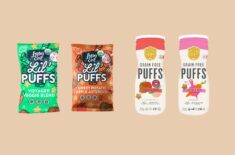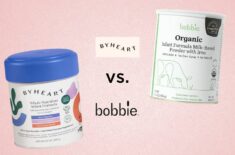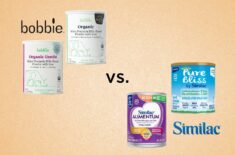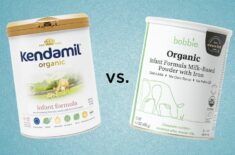Overview
Did you know that spinach leaves are a great source of calcium, vitamin A, iron, and selenium? This wonderful leafy green vegetable packs a lot of nutrients your little one needs. (1)
Spinach leaves are also known for their high concentrations of vitamin K and polyphenols, beneficial plant compounds that, together with vitamin K, help promote healthy bones, blood, and cell function. (1)
Is spinach good for babies? Absolutely! This leafy green vegetable also contains B vitamins that are essential for a baby’s growth, carotenoids that support the development of your baby’s vision, and, when eaten alongside foods with vitamin C, spinach helps the body to absorb more iron. (2)
Can my 6 month old have spinach? How do I prepare spinach for my 6 month old? Why can’t babies eat spinach? How do I cook spinach for my 8 month old? Find the answers below.
Top Reasons To Serve Spinach In BLW
Spinach may not be an obvious choice when it comes to finger foods, especially in the baby-led weaning (BLW) method, where your little one picks up the food and feeds themselves.
So if you’re looking for ways to add spinach into your baby’s diet, here are the top reasons why you should include this yummy leafy green vegetable on the menu:
- Highly nutritious
- Easy to prepare
- Versatile
- Easy to hold or scoop
- Freezer friendly
- Portable
Nutrition Facts
According to USDA (United States Department of Agriculture), a 100-gram serving of baby spinach contains: (1)
- Energy: 27 kcal
- Protein: 2.85 g
- Calcium: 68 mg
- Iron: 1.26 mg
- Magnesium: 92.9 mg
- Potassium: 582 mg
- Vitamin A: 283 mcg
- Folate: 116 mcg
- Fiber: 1.6 g
- Phosphorus: 39 mg
- Zinc: 0.45 mg
Most of the calories found in spinach are from protein and carbohydrates.
Other Health Benefits
Improves Bone Health
- Consuming adequate amounts of vitamin K helps improve bone health by helping to increase calcium absorption. (3)
Prevents Constipation
- Being high in fiber and water, which are widely known to help prevent constipation, spinach helps promote a healthier digestive tract. (4)
Improves Overall Health
- Eating food high in vitamin A, especially from plant-based sources such as spinach and other leafy green veggies, is important for children’s eyesight and immune system. Vitamin A also helps the heart, lungs, and kidneys to work properly. (5)
How To Prepare Spinach For Baby Food Recipes
Frozen, canned, or fresh spinach can be steamed, boiled, or sauteed. It’s also easy to incorporate spinach with various healthy recipes you may already be preparing for your family.
Some delicious recipes and meal ideas you can include spinach in are:
- Pastas
- Soups
- Lunchbox sandwiches
- Omelets
- Smoothies
- Fritters
- Smooth purée
- Muffins, pancakes, waffles
Many of these meal ideas usually contain certain allergens like wheat/gluten and dairy. Make sure you consult your pediatrician before introducing allergens to your baby, especially if they’re under six months of age and have a family history of allergens.
How To Select And Store Spinach For Baby-Friendly Recipes
According to the Environmental Working Group (EWG)’s 2021 Shopper’s Guide to Pesticides in Produce, spinach is one of the Top 12 “Dirty Frozen” foods. (6)
Being one of the most contaminated foods with pesticides, choosing organic and fresh spinach may be a good idea.
When preparing baby-led weaning recipes, you can purchase bagged fresh spinach, which allows you to avoid buying wilted or damaged leaves. Frozen spinach can be a good option as well. Again, be sure it’s certified organic rather than conventionally grown.
To ensure proper storage, keep spinach in an airtight container in the vegetable crisper of your fridge and make sure to keep it dry.
Is Spinach A Choking Hazard?
Spinach is not a choking hazard, though some flecks of raw or cooked spinach leaves can stick to a baby’s tongue, which can cause some gagging.
Also, since whole, fresh spinach leaves can be challenging for babies to chew and swallow, make sure to finely dice raw and cooked spinach to minimize the risk.
Is Spinach An Allergen?
Spinach allergies are rare, although a cross-allergy to latex and spinach has been reported. (7)
Those with hypersensitivity to latex may also experience Oral Allergy Syndrome resulting in short-lived itching in the mouth. However, it is very unlikely to result in a dangerous reaction. (8)
Being naturally high in histamine (a chemical found in the body’s cells that causes allergy symptoms like runny nose or sneezing), some individuals may also experience symptoms similar to an allergic reaction after ingesting large quantities of spinach. (9)
Start by serving small amounts of spinach to easily observe any adverse reaction, then gradually increase the amount later on.
Other Food Safety Issues
Spinach is also known to contain nitrates, a naturally-occurring plant compound that may negatively affect the oxygen levels in the blood when consumed excessively. (10)
In general, health organizations like the American Academy of Pediatrics (AAP) and the European Food Safety Authority do not view nitrates found in vegetables as a concern for most healthy children. (11)
Can You Give Spinach To Your Child Every Day?
The answer is yes, mama! Though small in size, spinach packs a big amount of essential vitamins and minerals your growing child needs for their daily nutrient requirements.
It helps promote well-balanced, complete nutrition, focusing on improving eyesight, bone health, boosting the immune system, and is packed with lots of nutrients for supporting your child’s growth and development. (1)
When Can Babies Eat Spinach?
According to the AAP (American Academy of Pediatrics), it is recommended that babies start exploring solid foods at six months. (12)
When your baby shows signs of readiness for solid foods, you can introduce spinach into their diet.
How Do You Prepare Spinach For Baby Led Weaning?
Leafy green vegetables like spinach are often treated with pesticides and can cause a higher risk for E. coli infection. When preparing baby food using fresh spinach leaves, thoroughly wash it first to avoid these two health issues. (13)
6+ Months Old:
Thoroughly wash, cook, and slice spinach into small pieces. You can put spinach into easy-to-scoop foods like soups or mix it in with mashed vegetables or yogurt.
Mixing cooked and minced spinach into egg dishes like omelet and frittata is also a good idea.
When accompanied with vitamin C, your baby’s body can absorb more of the plant-based iron in spinach, so try drizzling spinach leaves with citrus juice.
12+ Months Old:
At this age, when your child’s ability to chew and swallow or chew and spit out food continues to improve, you can start to introduce raw spinach. Mixing it in with a salad may be a good idea.
Expect your child to reject raw spinach at first as you’re introducing a new texture to their palate. Try to lead them by example and show them how to bite and chew food like raw spinach to help them learn how to eat it.
How Do I Introduce Spinach To My Baby In BLW?
Adding spinach into easy-to-hold and easy-to-scoop foods is the best way to introduce spinach in the baby led weaning (BLW) method.
Can My 6 Month Old Have Spinach?
Yes! When your baby shows signs of readiness for solid food, you can start introducing spinach into their diet.
How Do I Prepare Spinach For My 6 Month Old?
For babies aged 4-6 months old, prepare spinach by cooking it until tender, then cutting it into small pieces.
Why Can’t Babies Eat Spinach?
Once babies are ready to eat solid foods, they can eat spinach prepared according to their age:
- For 4-6 months old (cook until tender, and cut into small pieces)
- For 7-12 months old (serve raw or cook until tender, and cut into small pieces)
- For 12+ months old (serve raw or cook until tender, and cut or tear into smaller pieces)
How Do I Cook Spinach For My 8 Month Old?
Dice cooked spinach and put it into easy-to-scoop foods like soups or mixed with mashed vegetables or yogurt. Spinach omelet and frittata are also great ideas.
2 Easy, No-Fuss Recipes To Incorporate Spinach
- Smoothies – Get your blender ready and throw in breast milk or formula milk, strawberries, bananas, coconut yogurt, and cooked spinach (let cool before adding), then blend until smooth. Your baby may only take a sip or two of this nutritious smoothie, but know that they are still getting great nutrition with every sip.
- Homemade Sweet Potato & Spinach Puree – Perfect for those crazy mornings, this quick and easy recipe only requires cooked spinach and sweet potato, half a cup of bone broth, a tablespoon of coconut oil, a tablespoon of coconut yogurt, and ground cumin. Blend until smooth and serve warm.
Note: For BLW, your baby can easily feed his or herself by using a spoon or by using their hands.
Other Baby-Friendly Recipes & Dish Ideas You Can Try With Spinach
- Egg And Spinach Cups
- Soups – Make a pot of minestrone or lentil soup with spinach and other green leafy veggies.
- Quinoa Meatballs or Meatloaf – Add spinach next time you make meatballs or meatloaf.
- Spinach Pancakes – This gluten-free and dairy-free spinach recipe doesn’t take much prep time. Blend oats into flour, mix spinach, banana, egg, olive oil (instead of butter). Cook on a frying pan over medium heat, then cool before serving.
REFERENCES
(1) https://fdc.nal.usda.gov/fdc-app.html#/food-details/1999632/nutrients
(2) https://foodinsight.org/vitamin-c-and-iron-a-perfect-match/
(3) https://www.ncbi.nlm.nih.gov/pmc/articles/PMC5726210/
(4) https://www.hopkinsmedicine.org/health/wellness-and-prevention/5-foods-to-improve-your-digestion
(5) https://ods.od.nih.gov/factsheets/VitaminA-Consumer
(6) https://www.ewg.org/foodnews/dirty-dozen.php
(7) https://www.medicaljournals.se/acta/download/10.1080/000155500750012559/
(8) https://onlinelibrary.wiley.com/doi/abs/10.1111/j.1398-9995.1997.tb02533.x
(9) https://www.ncbi.nlm.nih.gov/pmc/articles/PMC5705351/
(10) https://www.ncbi.nlm.nih.gov/pmc/articles/PMC4525132/
(11) https://efsa.onlinelibrary.wiley.com/doi/pdf/10.2903/j.efsa.2010.1935
(12) https://www.cdc.gov/nutrition/infantandtoddlernutrition/foods-and-drinks/when-to-introduce-solid-foods.html
(13) https://www.mayoclinic.org/diseases-conditions/e-coli/symptoms-causes/syc-20372058













